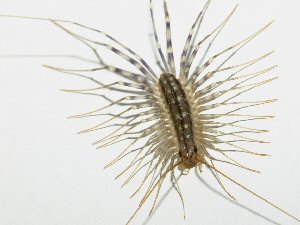House Centipede
 Scientific Name
Scientific Name
Scutigera coleopterata
Habitat
Though house centipedes are found both indoors and outdoors it is the occasional one on the bathroom or bedroom wall, or the one accidentally trapped in the bathtub, sink, or lavatory that causes the most concern. Centipedes prefer to live in damp portions of basements, closets, bathrooms, unexcavated areas under the house and beneath the bark of firewood stored indoors. House centipedes feed on small insects, insect larvae, and on spiders. Thus they are beneficial, though most homeowners take a different point-of-view and consider them a nuisance.
Description
The body is 1 to 1-1/2 inch long, but its 15 pairs of legs make it appear to seem much larger. The body is grayish-yellow with 3 dark stripes extending along the full length of the back. The legs are long in proportion to the body size, and they have alternate light and dark bands running around them.
Bite
Technically, the house centipede could bite, but it is considered harmless to people.
Control
Please contact your local county extension office for current information.
